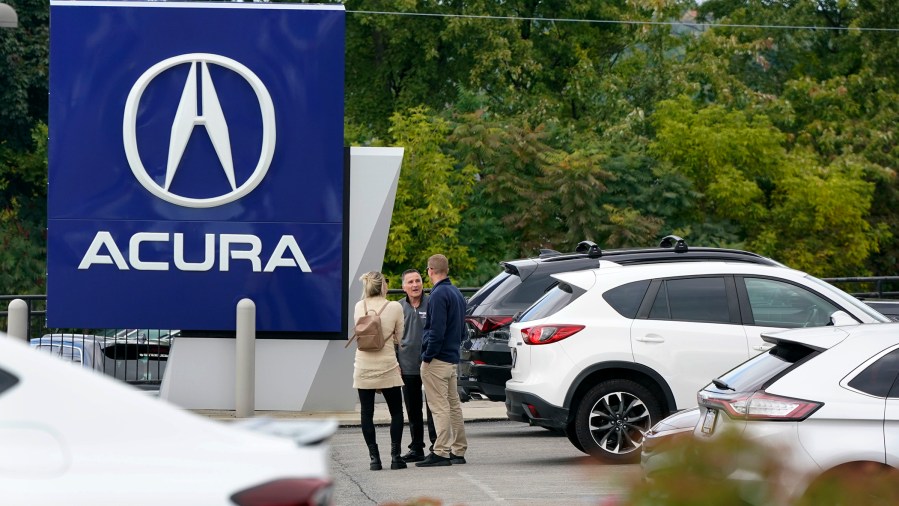‘Remember to shop around’: Owning a car gets more expensive as interest rates soar

High interest rates and inflation that balloon car payments, maintenance and insurance are keeping the cost of car ownership high, experts said this week.
That means that while the price of used cars is down 11.6 percent from a year ago, according to the new Manheim Used Vehicle Value Index released Monday, the cost of financing a car and keeping it fit for use is rising.
“Used car prices seem to be decreasing at the wholesale level, but not necessarily translating into savings for consumers due to high interest rates and other costs associated with purchasing a vehicle,” Mike Trudeau, executive vice president of business development at Montway Auto Transport, told The Hill.

Car prices are steadily dropping
Wholesale used car prices dropped 1.6 percent from June to July, far slower than a 4.2 percent dip the previous month, which marked the largest monthly decrease in used car prices since the start of the pandemic.
Used cars now have the same index value they did in April 2021, just over one year into the pandemic, said Chris Frey, senior manager of economic and industry insights for Cox Automotive, in a statement included in the Manheim Used Vehicle Value Index release.
“While the year-over-year price drop was again double-digit, let’s put some perspective on that. From July 2020, there were 22 straight monthly double-digit increases through April 2022; we’ve had just six double-digit declines since October last year, with only four of them consecutive,” Frey explained.
Frey said he did not foresee wholesale used car price reductions “of serious import” through the end of the year.
New car prices also remain high, but they’ve stabilized from their meteoric price rise after the pandemic restricted vehicle production, lowering supply amid increased demand.
The average buyer paid $48,808 for a new car in June, according to an analysis by Kelley Blue Book. That’s a 1.6 percent increase year over year, the smallest since the pandemic began.
Trudeau also anticipated the price of new cars may fall later this year or next.
More Americans looking to buy despite costs rising
With sticker shock slowing, some American car buyers are looking to buy again.
Used car sales were up 6 percent from June to July, Manheim found, and more Americans said they planned to purchase a car within the next six months than at any point over the past nine months.
But an auto loan payment may be significantly higher now, with the Federal Reserve setting interest rates at a 22-year high, than when rates were near zero at the beginning of 2022.
“If you were to finance a $20,000 used car with a loan term of 60 months, even a small increase in the interest rate could result in paying hundreds or even thousands more over the life of the loan,” Trudeau explained.
The Fed is weighing additional interest rate hikes at its September meeting as it works to bring inflation down to its 2 percent target. From credit card debt to mortgages, high interest could make it more expensive to borrow money.
Americans have weathered historic inflation for more than two years, and consumers’ car costs were not spared. While inflation cooled to 3 percent annually in June, down from its 9.1 percent peak the previous summer, motor vehicle maintenance prices remained elevated.
Car repair costs rose 19.8 percent year over year in June, according to federal consumer price data released last month. Maintenance and servicing was also up 8.6 percent annually, and insurance was up 16.9 percent.
‘We find alternatives’
Given the cost of car buying — and owning – these days, some consumers are getting creative.
“We find alternatives,” Brandon Chambers, who was visiting D.C. from Houston, told The Hill. When his son needed a car, Chambers said he would prefer to take out a 401(k) loan or a similar alternative than a traditional car loan.
While 401(k) retirement loan interest rates are typically a point or two higher than the prime interest rates, most employer-provided 401(k) plans allow participants to borrow up to $50,000 or 50 percent of their assets, whichever is less, tax-free.
The money, plus interest, must be paid back into the retirement account over a set period of time, typically quarterly over five years.
Trudeau encouraged car shoppers to explore their options and do their research.
“Always remember to shop around for the best loan rates and consider getting preapproved for a loan before heading to the dealership,” Trudeau suggested. “That way, you’ll have a better idea of what you can afford and avoid any surprises down the line.”
Beyond the car’s sticker value, a myriad of factors including the resale value, fuel efficiency, maintenance costs and reliability can contribute to the total price of the car.
Trudeau said dealers that his company works with are seeing potential buyers walk in with a monthly budget rather than a target sticker price.
Check for tax credits when buying a car
There’s also a clean vehicle tax credit available for buyers considering a new electric vehicle — up to $7,500 for qualifying vehicles.
The average price of an electric vehicle dropped to $53,438 in June, according to Kelley Blue Book, a 20 percent year-over-year decline from the peak of $66,390 last June.
The Federal Trade Commission proposed a rule that would protect car shoppers from bait-and-switch advertising tactics, crack down on junk charges and make it easier to compare the actual costs and conditions.
A preliminary analysis found the new rules would save consumers more than $29 billion over 10 years.
“Our proposed rule would save consumers time and money and help ensure a level playing field for honest dealers,” said Samuel Levine, director of the FTC’s Bureau of Consumer Protection, when the rule was announced last June.
Copyright 2023 Nexstar Media Inc. All rights reserved. This material may not be published, broadcast, rewritten, or redistributed.

